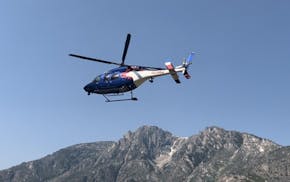A heat dome is baking Arizona and Nevada, where temperatures have soared past 115 degrees this week and doctors are warning that people can get third-degree burns from the sizzling asphalt.
At Lake Mead, which supplies water for 25 million people in three Southwestern states and Mexico, water levels have plunged to their lowest point since the reservoir was filled in the 1930s. In California, farmers are abandoning their thirstiest crops to save others, and communities are debating whether to ration tap water.
In Texas, electricity grids are under strain as residents crank their air conditioners, with utilities begging customers to turn off appliances to help avert blackouts. In Arizona, Montana and Utah, wildfires are blazing.
And it's not even summer yet.
"We're still a long way out from the peak of the wildfire season and the peak of the dry season," said Daniel Swain, a climate scientist at the University of California, Los Angeles. "Things are likely to get worse before they get better."
Global warming, driven by the burning of fossil fuels, has been heating up and drying out the American West for years. Now the region is broiling under a combination of a drought that is the worst in two decades and a record-breaking heat wave.
"The Southwest is getting hammered by climate change harder than almost any other part of the country, apart from perhaps coastal cities," said Jonathan Overpeck, a climate scientist at the University of Michigan. "And as bad as it might seem today, this is about as good as it's going to get if we don't get global warming under control."
With temperatures expected to keep rising as nations struggle to rein in their planet-warming emissions, the Western United States will need to take difficult and costly measures to adapt. That includes redesigning cities to endure punishing heat, conserving water and engineering grids that don't fail during extreme weather.
This month has offered glimpses of whether states and cities are up to that task and has shown they still have far to go.
From Montana to Southern California, much of the West is suffering from unusually high temperatures. Some 50 million Americans face heat-related warnings. Records have been tied or broken in places like Palm Springs, Calif., Salt Lake City and Billings, Mont.
As 115-degree temps cooked Phoenix's Roosevelt Row Arts District on Tuesday, Timothy Medina, 58, was perched on a black metal platform 12 feet above the sidewalk, finishing the blue lettering of a sign for a coffee shop. "It's brutal — that heat against the wall," he said. "Let me take a quick swig of water."
Extreme heat is the clearest signal of global warming, and the most deadly. Last year, heat killed at least 323 people in Maricopa County, which includes Phoenix, a record by far.
Outdoor workers are particularly at risk, along with older people and anyone without adequate shelter or access to air conditioning.
Across the country, heat waves are becoming more frequent, lasting longer and occurring earlier in the year, according to the Environmental Protection Agency. Severe heat early in the spring can be especially dangerous because it catches people off guard, experts say.
Severe heat waves also pose a challenge for power grids, particularly if operators don't plan for them. Rising temperatures can reduce the efficiency of fossil-fuel generators, transmission lines and even solar panels at precisely the moment that demand soars.
The effect on farms could cause supply issues and higher prices nationwide, said Mike Wade, executive director of the California Farm Water Coalition. California produces two-thirds of the country's fruit and one-third of its vegetables.
Many California farmers are already using micro-irrigation, drip hoses and other water conservation methods. "We've stretched every drop," said Bill Diedrich, a fourth-generation farmer in Fresno County.
Agricultural communities are in peril if the crops and trees die without water.
"When you are operating a longstanding family farm, you don't want to be the one to lose it," said Eric Bream, the third generation in his family to run a citrus farm in California's Central Valley. Today he still has enough water. But "tomorrow everything could change on a dime."

JD Vance, an unlikely friendship and why it ended

Lewis Lapham, editor who revived Harper's magazine, dies at 89

Body of missing Minnesota hiker recovered in Beartooth Mountains of Montana
Mike Lindell and the other voting machine conspiracy theorists are still at it

